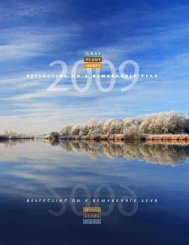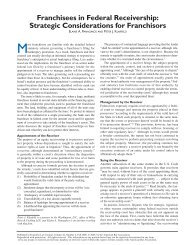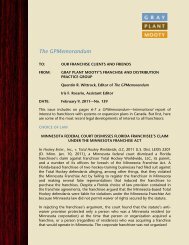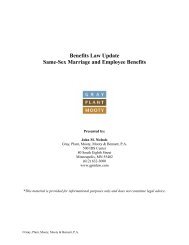Los Angeles Lawyer October 2008 - Gray Plant Mooty
Los Angeles Lawyer October 2008 - Gray Plant Mooty
Los Angeles Lawyer October 2008 - Gray Plant Mooty
Create successful ePaper yourself
Turn your PDF publications into a flip-book with our unique Google optimized e-Paper software.
Elimination of<br />
MCLE ARTICLE AND SELF-ASSESSMENT TEST<br />
By reading this article and answering the accompanying test questions, you can earn one MCLE elimination of bias credit.<br />
To apply for credit, please follow the instructions on the test answer sheet on page 27.<br />
BY GEORGE S. CARDONA and ANGELA J. DAVIS<br />
INSIDE<br />
THE BOX<br />
When exercising peremptory challenges, attorneys should<br />
keep in mind the three-step framework of Batson/Wheeler<br />
PEREMPTORY challenges are an<br />
important tool at trial, enhancing confidence<br />
in the jury’s fairness by permitting parties to<br />
remove jurors in whom they perceive bias or<br />
hostility even if that perception cannot be<br />
objectively verified. But as case law increasingly<br />
demonstrates, peremptories must be<br />
used with caution, because they may draw<br />
objections that call into question the integrity<br />
of the party seeking to exercise them.<br />
Peremptory challenges are “used precisely<br />
when there is no identifiable basis on which<br />
to challenge a particular juror for cause” and<br />
“may be wielded in a highly subjective and<br />
seemingly arbitrary fashion, based upon mere<br />
impressions and hunches.” 1 The latitude<br />
accorded peremptories is essential to their<br />
central functions: “to enable a litigant to<br />
remove a certain number of potential jurors<br />
who are not challengeable for cause, but in<br />
whom the litigant perceives bias or hostility,”<br />
“to reassure litigants—particularly criminal<br />
defendants—of the fairness of the jury that<br />
will decide their case,” and to “enhance the<br />
right to challenge jurors for cause because they<br />
allow litigants to strike prospective jurors<br />
who may have become antagonized by probing<br />
questions during voir dire.” 2 With this latitude,<br />
however, comes the risk that peremptories<br />
may be exercised based on impermissible<br />
criteria such as race.<br />
The case law that has developed around<br />
this risk has established a three-step framework<br />
for addressing challenges to the exercise<br />
of peremptories based on claims of discriminatory<br />
intent. These challenges are known,<br />
after the seminal cases, as Batson/Wheeler<br />
challenges. 3 Within this framework, to effectively<br />
support (or oppose) such challenges,<br />
counsel must understand the method of jury<br />
selection used by the court and must be prepared<br />
to assist the court in developing the necessary<br />
record.<br />
In 1965, in the midst of the civil rights<br />
movement, the U.S. Supreme Court in Swain<br />
v. Alabama first recognized that the exercise<br />
of peremptories by prosecutors deliberately<br />
George S. Cardona and Angela J. Davis serve as<br />
assistant U.S. attorneys for the Central District of<br />
California. The views expressed in this article are<br />
theirs alone and do not necessarily represent those<br />
of the U.S. Attorney’s Office or the U.S. Department<br />
of Justice.<br />
<strong>Los</strong> <strong>Angeles</strong> <strong>Lawyer</strong> <strong>October</strong> <strong>2008</strong> 25







